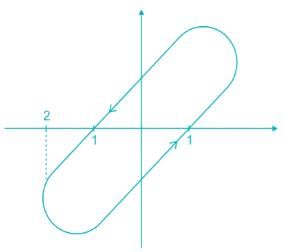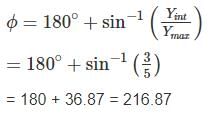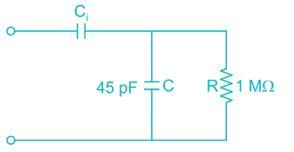Test: Electrical & Electronic Measurements- 7 - Electrical Engineering (EE) MCQ
10 Questions MCQ Test - Test: Electrical & Electronic Measurements- 7
A voltage signal V(t) = A + B sin ωt is fed to an oscilloscope with the coupling mode set to DC, other settings being appropriate. The displayed wave can be expressed as
Calculate the ratio of vertical to horizontal frequencies for an oscilloscope which display the following Lissajous figure.


| 1 Crore+ students have signed up on EduRev. Have you? Download the App |
A sinusoidal waveform, when observed on an oscilloscope, has a peak to peak amplitude of 4 cm. If the vertical sensitivity setting is 7.5 V/cm, the rms value of the voltage is__ (in V)
A single channel analog oscilloscope is operated in X-Y mode. An ellipse rotating in anticlockwise direction and having major axis in 2nd and 4thquadrants displayed on the screen. The peak Y deflection is at 5 divisions and Y intercept is at 3 divisions. The phase difference between both the input signals is ______
An electrostatically deflected CRT has plane parallel deflecting plates which are 2.5 cm long and 0.5 cm apart. The distance of the screen form the center of the plates is 20 cm. The accelerating voltage is 2500 V. The deflecting voltage required to get the corresponding deflection of 4 cm on the screen and the velocity of the electron beam entering the field respectively are.
In an analog single channel cathode ray oscilloscope (CRO), the x and y sensitivities are set as 1ms/div. and 1V/div. respectively. The y-inputs is connected to a voltage signal 4 cos (200 πt – 45°) V. The trigger source is internal, level chosen is zero and the slope is positive. The display seen on the CRO screen is
The input impedance of a CRO is equivalent to a 1 MΩ resistance in parallel with a 45 pF capacitance. It is used with a compensated 10 to 1 attenuation probe. The effective input capacitance at the probe tip is
A Lissajous pattern on the oscilloscope is stationary having 8 vertical maximum values and 6 horizontal maximum values. The frequency of vertical input of the frequency of horizontal input if the frequency of horizontal input is 1800 kHz is – (in kHz)
The below given ellipse is displayed on the screen when a CRO is operated in x-y display mode. The phase difference between both input signals is – (in degree)

A CRO has an anode voltage 3000 V and parallel deflection plate 3 cm long and 7 mm apart. The screen is 35 cm from the centre of the plates. Find the input voltage required to deflect the beam through 4 cm. The input voltage is applied to the deflecting plates through amplifiers having an overall gain of 100.



























